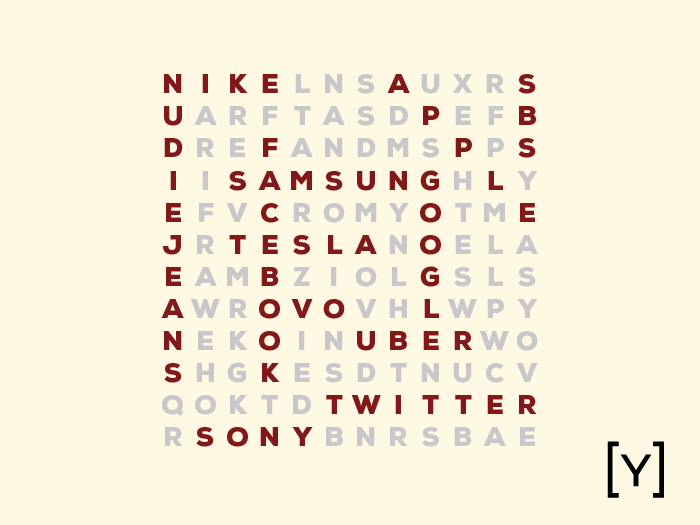Developing a brand name | Four types of brand name
Developing a brand name and identity
Branding isn’t easy. Brand marks, colour palettes, core messaging and graphic assets all take hard work and careful consideration to genuinely establish your company’s identity and positioning in the market. Something often overlooked is that those brand elements can (and should) evolve over time, however the name of your brand is generally the one element that is with you for the long haul.
If you don’t invest in getting your brand name right, you might just end up like Mercedes-Benz who went to market in China with the ‘Bensi’, which they later discovered translated to ‘rush to die’, or Holden with their Terracan, which was quickly labeled a can of terror! Not ideal for the family vehicle..
The reason a brand name generally lives on the longest is because it’s what most of your equity is attached to. While we can all get swept up in fads (I still can’t believe it’s not butter?!), the truest indicator of an effective name is whether it stands the test of time. To do that, it needs to resonate with your audience, be representative of your company, and also be memorable.
So how do you go about coming up with a name that will effectively represent the brand, stand out from competitors and be authentic to the personality of the company? The process can and should be extremely rigorous. It should involve competitor and market research, review of your brand strategy, brainstorming, shortlisting and testing, all to ensure the name you decide on is going to tick all of the boxes. In the end, it’s setting the criteria of those boxes which is pivotal to a successful result.
Here are my top ten brand naming criteria
These are questions you should ask as your starting point when deciding if a name is right or not.
- Does it capture your brand essence?
- Will it appeal to your target audience?
- Is it memorable?
- Is it easy to spell and say?
- Will it be easy to find on the web?
- Is it appropriate in all languages?
- Will it still be relevant in 5 years?
- Is it unique? And not similar to any other names?
- Can you trademark it?
- Is the domain available?
The right brand name should answer yes to all of those questions. But let’s take a step back – how do you come up with the name in the first place? Well, here at Yoke we begin with four themes. These themes allow you to think within a set of guidelines which can make it a little less daunting, however no idea is ever a bad idea… at least for now.
Descriptive
Descriptive names are exactly that – they describe what it is the company/product or service, is or does.
Think PayPal, Internet Explorer or Toy’s R Us. Even companies named after their founder/s, like PWC (Price Waterhouse Coopers), fall within this category.
The plus is that your target audience can easily identify what it is you do as it obviously communicates the brand story.
The downside is that you can risk being unremarkable, and it could limit your future business growth into other areas.
Evocative
Evocative names go beyond the simple descriptor and evoke the positioning of the company through metaphor. A vivid image of something they can align to.
Think Virgin, Apple or Amazon.
The plus is it helps to communicate your brand positioning quite clearly, as long as the metaphor you’ve chosen is right for your business.
The downside is that brands that go the evocative path must work incredibly hard to connect meaning from the name to the brand.
Experiential
Experiential names are linked to direct human experience.
Think Safari, Shower Power or Seek.
The plus is it helps set the expectation of what your audience can experience when dealing with your company.
The downside is that these types of names are rather common, and there is an overuse of many words such ‘smart, power and fast’, which can create trademarking issues and make it difficult to cut through the noise.
Invented
Invented names are simply made up, or are adaptations of existing or latin words. Inventing a new word can be harder than it sounds, as it’s imperative that the sound of the word still reflects your brand essence.
Think Kleenex, Hoover and Exxon.
Studies have proven that how certain words make our mouth feel and the sounds they create, can cue an interpretation or envoke a feeling. That means that eve a made up word can still have the ability to represent a brand’s personality. Invented names also have a stronger likelihood to become synonymous with the products or services they represent, such as Kleenex and Hoover, however this is dependent on the category/industry, competition, marketing budget and other factors.
The plus is that they are truly unique and easy to trademark.
The downside is that once again, they need to work hard to create meaning and connect it to the brand.
The next step is to go through and shortlist those you think have potential, and check those against your criteria. You may only have 1 that meets all criteria, you might have 20. Select the best 3, and test those within your business, or with trusted associates. You can even invest in paid testing (focus groups) if budget permits. However, when you make that final decision, as long as you’ve invested ample time and effort into following the process, you can be confident that it will result in a name that will effectively represent your business. More importantly, it will stand the test of time!
If not, I still can’t believe it’s not butter…

